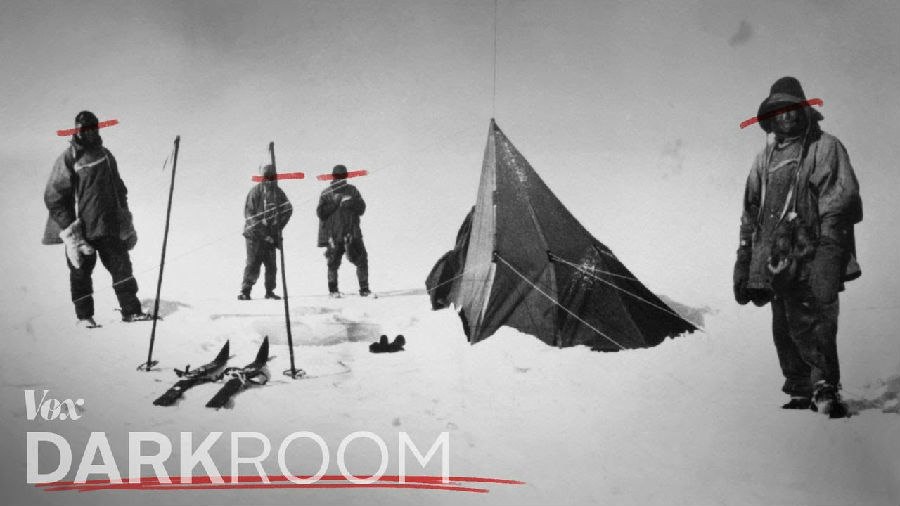Everyone in this photo died soon after it was taken.
这张照片拍摄后不久,照片中的所有人就都离开人世了。
These are British explorers standing at the South Pole in January 1912.
他们是1912年1月身在南极的一群英国探险家。
The photo marks the finish line of a race into the unknown.
这张照片标志着一场进入未知的竞赛的终点。
Two teams, one British, one Norwegian, trekked 900 miles into brutal territory and had to get back to safety before winter hit.
两支队伍,一支来自英国,一支来自挪威,长途跋涉900英里才来到了这片严酷的土地上,还不得不在冬季来临之前回到安全的地方。
And at first glance, this looks like a victory photo for the British.
乍一看,这像是宣告英国人胜利的一张照片。
Except that is the Norwegian flag.
只是,那面国旗是挪威的国旗。
And it only gets worse from here.
而更糟糕的事情还在后头。
Robert Falcon Scott was a meticulous planner.
罗伯特·法尔肯·斯科特是个一丝不苟的规划师。
And his dream was to be the first person to reach the South Pole.
他的梦想就是成为第一个到达南极的人。
He and his English team of explorers and scientists had been conducting research in Antarctica and collected years of data on seasonal cycles on the continent.
他和他带领的英国探险爱好家和科学家团队一直在南极开展研究,多年来一直在坚持收集南极季节性循环的数据。
These lines show what they estimated average temperatures would be throughout the year,
这些是他们估计的南极全年平均温度的变化曲线,
with summer ranging from around 30 to negative 10 degrees Fahrenheit, and huge drops beginning around April.
曲线显示,南极夏季的气温在30℉~-10℉之间((约-1℃~-23℃),并且从4月份开始,气温开始大幅下降。
Remember this chart because later, it will help us understand Scott’s decision-making.
请大家记住这张表,因为稍后,它将帮助我们理解斯科特的决策。
Scott planned to use pony transport for the first 425 miles across the Ross Ice Shelf,
斯科特计划乘小马拉的车穿越罗斯冰架之旅的前425英里,
shoot them at the base of the Beardmore Glacier, and finish the rest of the journey on foot.
然后在比尔德莫尔冰川的底部射杀它们,再之后徒步完成剩下的旅程。
Which included a 125-mile hike across the top of the glacier, 350 more miles to the pole, and all the way back again,
包括在冰川顶部徒步125英里,再走350英里到达极点,然后远路返回,
all while hauling hundreds of pounds of equipment.
一路上还要拖着数百磅重的设备。
Using ponies and brute strength made sense to Scott at the time:
在当时,使用小马和蛮力对斯科特来说是行得通的:
British explorers had used this method to haul equipment during an earlier attempt on the South Pole.
因为在早期的南极探险中,英国探险家就曾使用过这种方法来拖运设备。
Plus, the English didn’t have experience with the other good option: dog teams.
另外,英国人还没有尝试过另一个其实更好的选择,那就是使用狗拉雪橇的经验。
And they believed man-hauling was the surest way to make the tricky climb up the glacier and on to the Polar Plateau, where the South Pole sits.
他们以为,要想爬上冰川,登上南极所在的极地高原,最可靠的办法就是用人来拉设备。
It was hard, slow work, but the route they were on had reached the plateau before, and it seemed to be worth the effort.
这是一项艰苦而缓慢的工作,但他们所走的路线以前也曾到达过高原,所以似乎值得一试。
But Scott’s team wasn’t alone.
但斯科特的团队并不孤单。
Norwegian explorer Roald Amundsen was camped nearby.
挪威探险家罗尔德·阿蒙森就驻扎在附近。
And he wanted to get to the pole first.
他也想先到达极点。
The Norwegian team, all of them expert skiers, knew how to travel in cold conditions.
这支挪威团队都是滑雪高手,知道如何在寒冷的环境中前行。
And to make matters worse for the English, Amundsen had dogs — and he knew how to use them.
更糟糕的是,阿蒙森还有狗,他也知道如何利用那些狗。
News of the Norwegians’ last-minute bid worried Scott, but he was still optimistic.
挪威人在最后一刻叫板的消息让斯科特感到有些担忧,但他还是很乐观。
Amundsen had started about 60 miles closer to the pole but was taking a route not yet proven to be passable.
阿蒙森出发时距离极点大约有60英里,但所走的路线尚未被证明是否可行。
Coming against an unknown obstacle or falling into an unmarked crevasse could end his attempt prematurely.
遇到一个未知的障碍或掉进一个没有标记的裂缝,都可能提早结束他的尝试。
But that’s not how it happened.
但事实并非如此。
By the time Scott reached his goal, Amundsen’s flag was there waiting for him.
当斯科特到达终点时,阿蒙森的旗帜已经在那里等着他了。
The Norwegians and their dogs had comfortably reached the pole five weeks earlier and were almost back to their starting point by the time the English arrived.
挪威人和他们的狗在五周前就轻松地到达了极点,当英国人到达时,他们都快回到起点了。
Scott and his team were heartbroken.
斯科特和他的团队的心都碎了。
They took this photo outside of Amundsen’s tent the day they started their long journey back.
这张照片是他们在阿蒙森的帐篷外拍摄的,那天他们开始了他们漫长的回程之旅。

Scott wrote: Left a note to say I had visited the tent with companions.
斯科特写道:我留这张便条,是想说我和同伴们参观了这个帐篷。
Bowers photographing and Wilson sketching.
鲍尔斯负责拍摄,威尔逊则负责画素描。
We have turned our back now on the goal of our ambition and must face our 800 miles of solid dragging — and good-bye to most of the daydreams!
我们现在已经背弃了我们的雄心壮志的目标,还必须面对返程800英里的长途跋涉——再见了,大部分的白日梦!
This is where the trouble really begins.
此时才是麻烦真正开始的地方。
It’s mid-January in this photo — still the height of the Antarctic summer.
这张照片拍摄于一月中旬,当时仍然是南极的盛夏。
Told you this chart was coming back.
告诉你了吧,这张图又回来了。
According to their research, the team had about 3 months left before temperatures on the Ross Ice Shelf, the last leg of the journey back, would drop to deadly levels.
根据他们的研究,在返程最后一段的罗斯冰架的温度降至致命程度之前,研究小组还有大约3个月的时间回到那里。
That left plenty of time to make the long trek on foot.
这样,他们就有足够的时间徒步长途跋涉。
But this isn’t what happened in 1912.
但1912年的情况不同了。
This is that average line again, and these are the temperatures Scott’s party endured that summer:
这是南极在那段时间常规的温度变化曲线,这是斯科特一行人那个夏天实际面临的温度:
consecutive days of temperatures around minus 40 degrees Fahrenheit.
连续几天温度都在-40℉(约-40℃)左右。
Those conditions, at prolonged exposure, are not survivable.
这样的温度,长时间的暴露是无法生存的。
The first man died here — he collapsed and soon went comatose following several falls on the glacier.
团队中第一个死去的人死在了这里——他在冰川上摔了几次之后就瘫倒了,很快就昏迷不醒了。
The next man died about a month later, after crippling frostbite in his hands and feet began hurting the team’s progress and their chances of survival.
大约一个月后,另一名男子也离开了人世。当时他已经手脚严重冻伤,开始影响到团队的进展和生存机会了。
Nearly unable to walk, he left the tent and sacrificed himself to a snowstorm.
由于几乎已经无法行走,他便离开帐篷,在暴风雪里祭献了自己。
The last three, including Scott, made it here before getting trapped in their tent by a blizzard, just 11 miles from the supply depot that would have saved their lives.
包括斯科特在内的最后三个人在被暴风雪困在帐篷里之前到达了这个离能救他们命的补给站只有11英里的地方。
The tent, along with the bodies, journals, and photographs, was found 8 months later by a search team.
8个月后,搜查队才发现了这个帐篷以及队员们的尸体、日记和照片。
As time went on, Scott’s legacy vacillated between fearless explorer and bumbling fool who tried to take ponies into the Antarctic.
随着时间的推移,斯科特留给世人的形象在无畏的探险家和笨手笨脚,试图把小马带到南极的傻瓜之间摇摆不定。
But the thing is his plan should have worked.
但问题是,他的计划本来是行得通的。
Measurements from modern weather stations along his route show the predictions he was relying on were impressively accurate.
从他的路线沿线的现代气象站的测量结果来看,他所依赖的预测惊人的准确。
What Scott couldn’t have known is that 1912 was an anomaly —
只是,斯科特不可能知道的是1912年是一个反常的年份——
the temperatures his party suffered through occur roughly once every 15 years, turning an already risky venture into a hopeless one.
他的团队经历的低温大约每15年才会发生一次,这才把本来就有风险的一次冒险变成了一次绝望的冒险。
The photo they took outside of Amundsen’s tent was meant to be a gentlemanly admission of defeat at the end of a long race.
他们在阿蒙森帐篷外拍的这张照片原本是在漫长的比赛结束后,以一种绅士的姿态承认失败的照片。
But instead, it was the starting line of a race they didn't see coming — a desperate attempt to escape from the coldest place on Earth.
结果却成了他们没有预见到的一场比赛——逃离地球上最寒冷的地方的一次绝望的努力——的起点。












